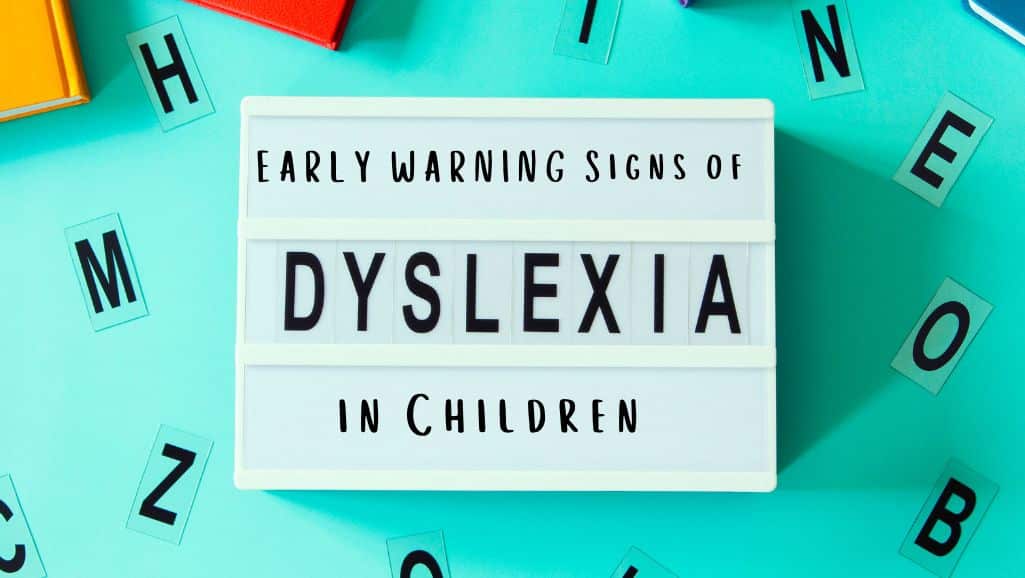
Dyslexia is a learning disability characterized by reading, writing, and spelling difficulties. We discuss the early warning signs of dyslexia in children. Signs of dyslexia can be difficult to recognize before a child enters school, but some early clues may indicate a problem.
We specialize in helping children overcome dyslexia signs and symptoms. Book a free consultation to discuss your child’s learning needs.
Signs that a young child may be at risk of dyslexia include:
A family history of dyslexia
Children with a family history of dyslexia are more likely to have dyslexia themselves. Data from fifteen studies examining children at familial risk for dyslexia estimated that, on average, 45% of children with a family history eventually show characteristics of dyslexia (Snowling & Melby-Lervåg, 2016).
Late at talking
Research has revealed a dramatic link between the abnormal development of spoken language and dyslexia. In several longitudinal studies, children with preschool speech or language impairments have been found to remain at risk for developing reading disabilities at older ages (Scarborough, 2005).
A study by Valtin, based on one hundred pairs of dyslexic and typical children, found indications of backwardness in speech development among dyslexic children. According to Hornsby, about 60 percent of dyslexic students were late talkers.
By five, a child should have acquired basic language, and only the complexity of usage and vocabulary will improve with the years. If a child still has a speech defect, however mild, or uses immature grammatical structure in their sentences when they start school, this should alert parents and teachers to future problems with reading and writing.
Trouble with nursery rhymes
Children at risk for dyslexia may have a hard time learning nursery rhymes or song lyrics that rhyme. Nursery rhymes are essential for young children because they help develop an ear for language.
Bryant et al. found a strong relationship between early knowledge of nursery rhymes at age three and success in reading and spelling at age six, even after differences in social background, IQ, and the children’s phonological skills at the start of the project were taken into account. Phonological skills help children understand how letters and letter patterns work to represent language in print.
The researchers concluded that knowledge of nursery rhymes enhances children’s phonological sensitivity, which in turn helps them to learn to read.
Can’t identify sounds inside words
By the time they go to school, most children can tell you when words sound alike or different, says Wood (2005). They can give you a string of “buh” words, like ball, balloon, bench, and bun, and enjoy alliteration (“an alligator ate Alice”). A child with dyslexia usually doesn’t understand what the fuss is about. They don’t hear the pattern in the “buh” words or appreciate the fun in alliteration.
Unable to identify letters from squiggles
A child with dyslexia takes longer to get to know letters than others. By the time they start school, they usually haven’t learned to identify all the letters and may confuse letters or random squiggles with each other.
Uninterested in words or letters
Preschool children usually enjoy writing letters and their names all over the place. A child with dyslexia usually doesn’t. In fact, a dyslexic child may be unable to write or recognize their own name by the time they start school.
Uninterested in hearing stories
Some dyslexic children don’t enjoy hearing stories. They don’t follow plots, don’t understand wordplay, and may walk right off in the middle of a story that other kids are begging for more of.
Can’t retell a simple story
Small children can tell you a story, albeit in an extended, roundabout way. They’re not succinct or sophisticated, but they get there. A child with dyslexia usually doesn’t get there. They find it hard to recall sequences of events, so retelling a story is virtually impossible for them, says Wood (2005).
They may also be unable to recall the name of the city or state they live in and have trouble remembering the order of the days of the week, numbers, and colors.
Late at walking
Twenty percent of dyslexic students were late walkers, according to Hornsby. Children usually take their first uncertain steps around twelve to fifteen months and walk well enough by eighteen months to no longer have to think about it – the activity has become automatic. If a child is not walking by eighteen months, there may be cause for concern.
Clumsy and accident-prone
Children with dyslexia are popularly thought of as clumsy and accident-prone, but while some dyslexic children are not well coordinated, many do brilliantly at sports. Clumsiness is less of a significant early pointer as late talking or even late walking. However, it is as well to bear it in mind.
If one’s child is poorly coordinated, sports like trampolining, judo, and swimming can help build up their confidence in their physical abilities and improve their overall coordination.
Overcoming dyslexia symptoms
Below are success stories of children who overcame their dyslexia symptoms and the difference it made to their lives:
References:
Bryant, P. E., Bradley, L., Maclean, M., & Crossland, J. (1989). Nursery rhymes, phonological skills and reading. Journal of Child Language, 16(02): 407-28.
Hornsby, B. (1984). Overcoming dyslexia. Johannesburg: Juta and Company Ltd.
Scarborough, H. S. (2005). Developmental relationships between language and reading: Reconciling a beautiful hypothesis with some ugly facts. In H. W. Catts & A. G. Kamhi (Eds.), The connections between language and reading disabilities (pp. 3–24). Lawrence Erlbaum Associates Publishers.
Snowling, M. J., & Melby-Lervåg, M. (2016). Oral language deficits in familial dyslexia: A meta-analysis and review. Psychological Bulletin, 142(5): 498–545.
Wood, T. (2011). Overcoming dyslexia for dummies. Indianapolis: Wiley Publishing, Inc.
